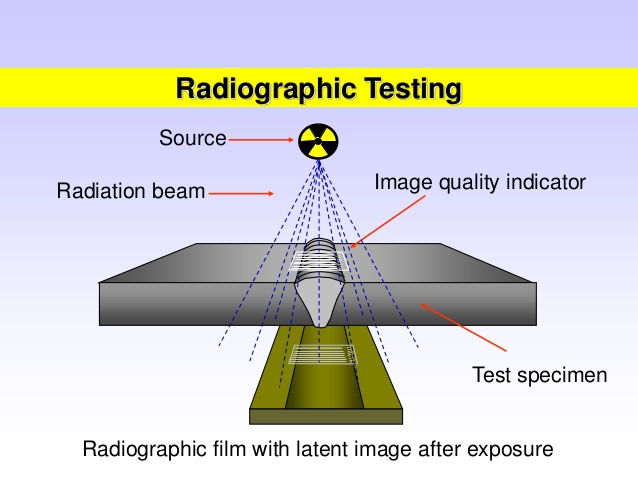What is Radiography Testing?
Industrial radiography is a method of non-destructive testing where many types of manufactured components can be examined to verify the internal structure and integrity of the specimen. Radiographic Testing (RT or X-ray or Gamma ray) is a non-destructive testing (NDT) method that examines the volume of a specimen. Radiography (X-ray) uses X-rays and gamma-rays to produce a radiograph of a specimen, showing any changes in thickness, defects (internal and external), and assembly details to ensure optimum quality in your operation
RT makes use of X-rays or gamma rays. X-rays are produced by an X-ray tube, and gamma rays are produced by a radioactive isotope.
Only qualified personnel should conduct radiography and radiographic interpretation because false readings can be expensive and can interfere seriously with productivity, and because invisible X-ray and gamma radiation can be hazardous.



Where is Radiography Testing done ?
RT usually is suitable for testing welded joints that can be accessed from both sides, with the exception of double-wall signal image techniques used on some pipe. Although this is a slow and expensive NDT method, it is a dependable way to detect porosity, inclusions, cracks, and voids in weld interiors. The radiographic film detects the radiation and measures the various quantities of radiation received over the entire surface of the film. This film is then processed under dark room conditions and the various degrees of radiation received by the film are imaged by the display of different degrees of black and white, this is termed the film density and is viewed on a special light emitting device.
Discontinuities in the material affect the amount of radiation being received by the film through that particular plane of the material. Qualified inspectors can interpret the resultant images and record the location and type of defect present in the material. Radiography can be used on most materials and product forms, e.g. welds, castings, composites etc.
Radiographic testing provides a permanent record in the form of a radiograph and provides a highly sensitive image of the internal structure of the material. All discontinuities are detected by viewing the weld shape and variations in the density of the processed film. This permanent film record of weld quality is relatively easy to interpret if personnel are properly trained.
Few Important Radiography Standards
ASTM INTERNATIONAL (ASTM)
- ASTM E 94, Standard Guide for Radiographic Examination
- ASTM E 155, Standard Reference Radiographs for Inspection of Aluminum and Magnesium Casting
- ASTM E 1030, Standard Test Method for Radiographic Examination of Metallic Castings
- ASTM E 1032, Standard Test Method for Radiographic Examination of Weldments
- ASTM E 1648, Standard Reference Radiographs for Examination of Aluminum Fusion Welds
- ASTM E 2104, Standard Practice for Radiographic Examination of Advanced Aero and Turbine Materials and Components
AMERICAN SOCIETY OF MECHANICAL ENGINEERS (ASME)
- BPVC Section V, Nondestructive Examination: Article 2 Radiographic Examination
AMERICAN PETROLEUM INSTITUTE (API)
- API 1104, Welding of Pipelines and Related Facilities: 11.1 Radiographic Test Methods
INTERNATIONAL ORGANIZATION FOR STANDARDIZATION (ISO)
- ISO 4993, Steel and iron castings - Radiographic inspection
- ISO 5579, Non-destructive testing - Radiographic examination of metallic materials by X- and gamma-rays - Basic rules
- ISO 10675-1, Non-destructive testing of welds - Acceptance levels for radiographic testing - Part 1: Steel, nickel, titanium and their alloys
- ISO 11699-1, Non-destructive testing - Industrial radiographic films - Part 1: Classification of film systems for industrial radiography
- ISO 11699-2, Non-destructive testing - Industrial radiographic films - Part 2: Control of film processing by means of reference values
- ISO 14096-1, Non-destructive testing - Qualification of radiographic film digitisation systems - Part 1: Definitions, quantitative measurements of image quality parameters, standard reference film and qualitative control
- ISO 14096-2, Non-destructive testing - Qualification of radiographic film digitisation systems - Part 2: Minimum requirements
- ISO 17636, Non-destructive testing of welds - Radiographic testing of fusion-welded joints
- ISO 19232, Non-destructive testing - Image quality of radiographs

 Aptest
Aptest





